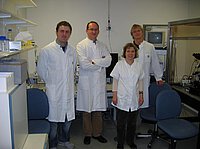Characterising a novel form of complicated hereditary spastic paraplegia
Applicant: Dr. Christian Beetz, Institut für Klinische Chemie der FSU Jena.
scientists involved:
- Dr. N. O. Dundar und Dr. S. Haspolat, Department of Child Neurology, Faculty of Medicine, Akdeniz University Antalya, Türkei
- Dr. Rebecca Schüle und Prof. L. Schöls, Hertie Institut für Klinische Hirnforschung, Tübingen
- Dr. G. Uyanik, Institut für Humangenetik, Universitätsklinikum Hamburg-Eppendorf
- Prof. C. Hübner und Prof. T. Deufel, Institut für Klinische Chemie und Laboratoriumsdiagnostik, Universitätsklinikum Jena
- Dr. F. Erdogan und Prof. P. Nürnberg, Atlas Biolabs GmbH, Berlin
The hereditary spastic paraplegias (HSPs) are neurodegenerative movement disorders. The unifying clinical feature is progressive weakness and spasticity of the legs. This feature may occur in iolation (pure forms) or be associated with a wide spectrum of other symptoms (complicated forms). All modes of inheritance are observed.
In the frame of a collaboration with Turkish neurologists, we identified a large family in which several members developed a spastic gate in early childhood. Older patients also show ataxie and mental retardation. Since all patients have consanguineous parents one may hypothesise a recessive mode of inheritance caused by a homozygous mutation. After exclusion of linkage to known recessive HSP loci we performed a SNP-based whole genome analysis. This revealed strong linkage to a single genomic region (LOD score 3.6) which does not overlap any of the known loci for HSP or inherited ataxias. We conclude that a novel inherited disease underlies the phenotype in this family. Based on present clinical data, the condition may best be classified as autosomal recessive complicated HSP.
The present project aims at: (i) a detailed clinical description according to standardised criteria, (ii) reduction of the number of candidate genes, and (iii) identification of the causative mutation. To this end, all patients will be seen by well-recognised experts in the fields of HSPs and inherited ataxias. DNA of additional family members, preferentially additional patients, will be collected. Ideally, this will allow narrowing of the candidate region. Leukocyte-derived transcriptome profiles will be used to identify genes from the genomic interval of interest that are not expressed in patients and, thereby, represent excellent candidate disease genes. Finally, selected genes will be sequenced.
Successful completion of the above sub-projects would represent a basis for several follow up studies. Screening of additional patients would help to define the frequency and the phenotypic spectrum of this genetic form of the disease. Also, an implementation into routine molecular diagnostic strategies would be possible. Functional studies on the gene product would likely increase our understanding of HSP and related phenotypes.





